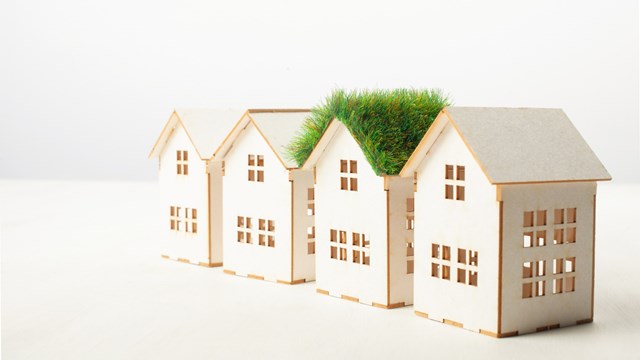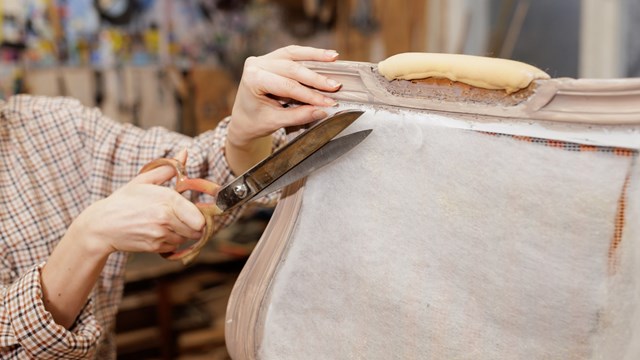
Real estate brokers are familiar with the scenario: An excited buyer enters a spacious apartment in a building located at a desirable address. Despite the fact that she's been warned by the broker that the interior has been modernized, the buyer is convinced that it will be love at first sight. But instead of her dream home she sees a bland space that has no character. Excessive renovation has resulted in an apartment that seems out of place in the charming pre-war building.
It's true that a new kitchen and bath can increase the value of your co-op and condo, but these changesas well as others that can be done to living or dining areas, bedrooms, hallways or storage spaceshould be done carefully while taking into consideration the period and style in which the apartment was built. The same rule applies to lobbies and other common areas in a residential building.
Authenticity is a Commodity
We know that when people buy a home they do so from an emotional standpoint, says Marilyn Harra Kaye, president of Prudential MLBKaye International Realty, a full-service brokerage firm in Manhattan. They go on their gut instincts. When they first walk into a potential home, they tend to either love it or hate it. According to Kaye, these days just about everyone goes for pre-war apartments and this has almost always been the case with many European and South American clients who don't relate to the austere look of more contemporary buildings. So if you own a pre-war gem, and are thinking about doing a renovation, she cautions against stripping the interior. Retaining original features such as light fixtures, moldings, arches, French doors, built-in shelving, stained glass, a pedestal sink or iron bathtub can make a difference of $100,000 to $200,000 when it comes time to sell.
Preserving assets from the past may mean hiring an artisan and it can sometimes be an expensive proposition, but it's a shame not to do so. As Kaye points out, undertaking a massive renovation could be a waste if the next owner attempts to put things back the way they used to be. As a general rule, she explains, when you maintain the old touches it keeps the price and value up. Two exceptions are the kitchen and bathroom where some things can't be used and must be replaced. But here, again, you should strive to stay as close to the old as possible. This can be achieved by reglazing old fixtures to give them a fresh appearance and enhanced durability. Reproductions of antique or period fixtures, which are becoming increasingly available in a wide range of prices, are another option.
It's unfortunate when the detail is removed during a renovation, agrees Roger Lang, a spokesman for the New York Landmarks Conservancy, a not-for-profit organization in Manhattan dedicated to preserving old buildings city-wide. If the building is plain, go ahead and renovate to your heart's content; but I think you should think twice before throwing away architectural details especially when we know buyers are eager to pay more for them. I cherish the fireplaces, the paneled doors. Some of the fancier ceilings have rosettes and plaster medallions. All these touches lend charm and authenticity to an apartment. Personally I feel a little sad when I see these being destroyed, because I think history and contemporary living can go hand in hand.
Restoring Rather Than Replacing
The New York Landmarks Conservancy publishes a restoration directory that lists a number of interior and exterior experts including design professionals, contractors, artisans, plasterers, suppliers and chimney sweeps. We can help, Lang adds. We're believers that wood windows that have been restored are a more durable choice, not to mention aesthetically superior, than some of the new windows that are on the market today. One hundred years later wood windows are still holding up great, and this can frequently lead to savings.
Joel Ergas, a principal of Forbes-Ergas Design Associates, Inc., an interior design firm in Manhattan, agrees that it's very important to get good professional advice from tradesmen who understand pre-war buildings. They can help you decide if it makes sense to replace your 75-year-old plaster wall with lightweight sheetrock. They can explore all the options and explain that if you skim the sheetrock with a coating of plaster it will have the look of an authentic plaster wall. Ergas adds, You also need someone who is knowledgeable about old plumbing and what to do if you run into asbestos.
Ripping out the 75-year-old plumbing in a bathroom, in order to install a new sink or bathtub, can open up a can of worms, according to Andrew Weinstock, owner and president of Porcelain Refinishing Corporation, a company in Flushing, New York that provides reglazing services for bathtubs, sinks and tiles in residential and commercial settings. He says that reglazing is a smart alternative that saves money and also makes sense, logistically, because sometimes the old-fashioned tub won't fit out the bathroom door and a wall or doorway has to be knocked out.
It's also a matter of comfort. According to Weinstock, when you're used to bathing in a roomy, six-foot tub, it's hard to switch to one of the smaller models available today. We do a lot of work in landmark buildings, he adds. They love us. Our service, which is basically cosmetic surgery, is ideal for these types of apartments. No fixture is too old for the reglazing process, which also takes care of cracks and holes. To date, the oldest tub refurbished by Weinstock and his crew dates back to the mid-1800's.
White is the most popular choice, but customers can select from a wide range of colors. In an average New York City-sized bathroom, Weinstock adds, a job that includes the tub and nearby tiles starts at approximately $750 and it takes one full day to reglaze with 24 hours to dry. To do just the sink, prices start at approximately $100 and this type of job also takes 24 hours to dry.
Looking Beneath the Surface
When I first moved to the Upper West Side 25 years ago there were pieces of marble and beautiful cornices on the sidewalk for the taking because the brownstones were being modernized, says Ergas. Today we've come into balance where people are starting to appreciate things of historical significance. They're not saying that modern is bad, although people do seem to be tired of modern, boxy interiors.
Whether you plan to refurbish by making only cosmetic changes, or to undertake a renovation that will entail replanning the placement of entire walls, Ergas recommends retaining vintage or reproduction features that are difficult or costly to reproduce in today's marketplace. Do research to find out in what period the building was constructed, he suggests. Visit other apartments in your building, especially those in which not much renovation has been done over the years. And don't forget to look below the surface for hidden treasures. You might find wood lurking below linoleum which was popular in the 1920s and 1930s. However, keep in mind that there are beautiful modern materials that simulate the look of marble, granite and other surfaces. Sometimes it doesn't have to be authentic, Ergas points out, just in the spirit of the time.
The Finishing Touches
The right furnishings can enhance a pre-war spacewhether turn-of-the century, Art Deco or more recentand make it more appealing to potential buyers. According to Marjorie Hilton of Marjorie Hilton Interiors, a Manhattan-based interior design firm, there are as many ways to approach this type of decorating project as there are clients who request her services because each co-op or condo resident has his or her own taste and preferences. However, a good place to start when dealing with a pre-war space is to research the colors, furnishings and accessories of that period.
One strategy is to make the shellthe floors, walls, ceilings, moldingsconsistent with the time the apartment was built, Hilton suggests. The furnishings, on the other hand, could be more 1990s especially if the furniture indigenous to that period was not very comfortable. But, she adds, there are no hard and fast rules. Some people might love historical colors, while others find them bland. An eclectic look can work just as well in an older space as in a modern one. Ergas adds, Don't be afraid to give the old fashioned aspects of your home a modern kick.
Diana Mosher is Associate Editor of The Cooperator.






Leave a Comment